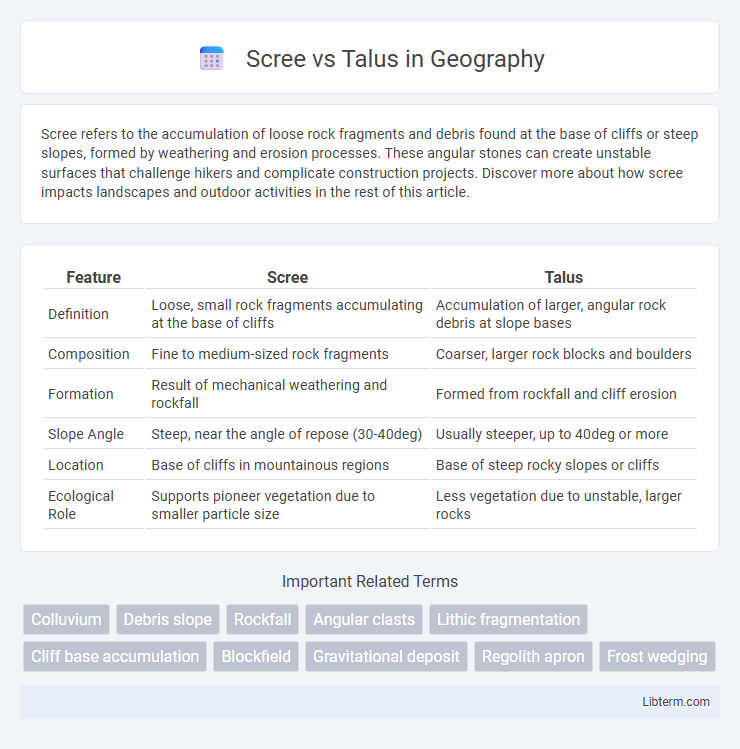Scree refers to the accumulation of loose rock fragments and debris found at the base of cliffs or steep slopes, formed by weathering and erosion processes. These angular stones can create unstable surfaces that challenge hikers and complicate construction projects. Discover more about how scree impacts landscapes and outdoor activities in the rest of this article.
Table of Comparison
| Feature | Scree | Talus |
|---|---|---|
| Definition | Loose, small rock fragments accumulating at the base of cliffs | Accumulation of larger, angular rock debris at slope bases |
| Composition | Fine to medium-sized rock fragments | Coarser, larger rock blocks and boulders |
| Formation | Result of mechanical weathering and rockfall | Formed from rockfall and cliff erosion |
| Slope Angle | Steep, near the angle of repose (30-40deg) | Usually steeper, up to 40deg or more |
| Location | Base of cliffs in mountainous regions | Base of steep rocky slopes or cliffs |
| Ecological Role | Supports pioneer vegetation due to smaller particle size | Less vegetation due to unstable, larger rocks |
Introduction to Scree and Talus
Scree and talus both refer to accumulations of broken rock fragments at the base of cliffs or steep slopes, formed through weathering and rockfall processes. Scree consists of smaller, angular rock debris typically found on steep slopes, while talus includes larger, more stable rock fragments forming a more compact slope. These geological features are key indicators of slope dynamics and erosion patterns in mountainous and rocky terrain environments.
Defining Scree: Key Characteristics
Scree consists of loose, angular rock fragments typically ranging from gravel to boulder size, accumulating at the base of cliffs or steep slopes due to physical weathering processes like freeze-thaw cycles. Its composition is often heterogeneous, reflecting the parent rock, and the steep slope angles, usually between 30 to 40 degrees, allow for frequent movement and reorganization of the debris. Unlike talus, scree is more unstable and less compacted, making it a dynamic terrain feature that plays a crucial role in slope morphology and sediment transport.
Understanding Talus: Main Features
Talus consists of large angular rock fragments accumulated at the base of cliffs, typically formed through freeze-thaw weathering processes in mountainous regions. Unlike scree, which is composed of smaller, more rounded debris, talus deposits are characterized by their size, sharp edges, and stability, creating distinct sloping formations. Talus slopes influence mountain erosion patterns and provide important habitats for specialized plant and animal species adapted to rocky environments.
Geological Formation Processes
Scree and talus are both accumulations of rock debris at the base of cliffs or steep slopes, formed primarily through weathering and erosion. Scree typically consists of smaller, more angular rock fragments resulting from freeze-thaw cycles that cause mechanical breakdown of rock. Talus piles tend to contain larger, more stable boulders and blocks, often formed from rockfall events where detached rock masses accumulate in a more consolidated manner.
Scree vs Talus: Differences Explained
Scree and talus both consist of broken rock fragments accumulating at the base of cliffs or slopes, but scree refers to smaller, more angular debris typically less than 2 inches in size, whereas talus includes larger, more stable rock blocks often exceeding 6 inches. Scree forms primarily through frost weathering and rockfall processes creating a loose, unstable surface, while talus piles result from gradual rockfall accumulation leading to a more consolidated, sloping deposit. Understanding the distinct particle sizes and formation dynamics helps differentiate scree's loose, fine-grained texture from talus's coarse, massive rock arrangements.
Locations and Examples Around the World
Scree and talus are common in mountainous regions worldwide, with scree typically found as loose, small rock fragments on steep slopes and talus as larger rock debris accumulations at the base of cliffs. Notable locations featuring scree include the European Alps and the Rocky Mountains in North America, while extensive talus slopes can be observed in Yosemite National Park, USA, and the Aoraki/Mount Cook region of New Zealand. These geological formations influence local ecosystems and serve as key indicators of weathering and erosion processes in alpine and temperate environments.
Ecological Impacts and Importance
Scree and talus slopes provide critical habitats for specialized flora and fauna, supporting biodiversity by offering unique microclimates and shelter from predators. These unstable rock accumulations influence soil formation and water retention, impacting local vegetation patterns and ecosystem stability. Their ecological role includes serving as natural barriers that control erosion and contribute to nutrient cycling in mountainous environments.
Hazards and Safety Considerations
Scree and talus slopes pose significant hazards due to their instability and frequent rockfall, creating risks for hikers and climbers. Loose, angular rocks in scree fields can shift unexpectedly, leading to slips and falls, while talus slopes often have larger, more unstable boulders that increase the danger of rockslides. Proper safety measures include wearing sturdy footwear, using trekking poles for balance, and avoiding loose rock areas during or after heavy rain or freeze-thaw cycles that exacerbate slope instability.
Human Interaction and Uses
Scree slopes, composed of small, loose rock fragments, present challenges for hiking and construction due to their instability but offer unique opportunities for geological study and adventure sports like scrambling. Talus deposits, formed from larger, angular rock debris accumulating at the base of cliffs, provide critical habitats for wildlife and natural pathways that have been historically used by indigenous peoples and hikers. Both scree and talus landscapes require careful navigation and management to ensure safety and preserve ecological balance in mountainous regions.
Summary: Choosing the Correct Term
Scree and talus both describe accumulations of rock debris at the base of cliffs or slopes, but scree typically refers to smaller, more angular fragments formed by frost weathering, while talus includes larger, more stable rock piles derived from rockfalls. Selecting the correct term enhances geological accuracy, especially in geomorphology and sedimentology studies, where precise rock fragment size and formation processes are critical. Proper usage supports clearer communication in environmental assessments, hazard mapping, and landscape evolution research.
Scree Infographic

 libterm.com
libterm.com